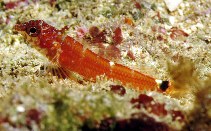| Family: |
Tripterygiidae (Triplefin blennies), subfamily: Tripterygiinae |
| Max. size: |
5.3 cm TL (male/unsexed); 4.5 cm NG (female) |
| Environment: |
demersal; marine; depth range 3 - 40 m |
| Distribution: |
Mediterranean Sea: Balearic Islands (Spain), southern Sardinia, Algeria, Tunisia, Israel, Lebanon, Cyprus, and southern Turkey. |
| Diagnosis: |
Dorsal spines (total): 17-19; Dorsal soft rays (total): 10-13; Anal spines: 2-2; Anal soft rays: 22-25. Body permanently red in color, females and non-territorial males with marbled head; in territorial males black; slightly dark, vertical bars, often white spots and bars along back (Ref. 4785). Territorial males with prolonged rays in second dorsal (Ref. 4785). |
| Biology: |
Adults inhabit dimly-lit areas, clinging to walls or ceilings (Ref. 4785). They feed on small invertebrates, especially harpacticoids (Ref. 4785). Eggs are hemispherical and covered with numerous sticky threads that anchor them in the algae on the nesting sites (Ref. 240). Larvae are planktonic which occur primarily in shallow, nearshore waters (Ref. 94114). |
| IUCN Red List Status: |
Least Concern (LC); Date assessed: 18 June 2014 Ref. (130435)
|
| Threat to humans: |
harmless |
Source and more info: www.fishbase.org. For personal, classroom, and other internal use only. Not for publication.

